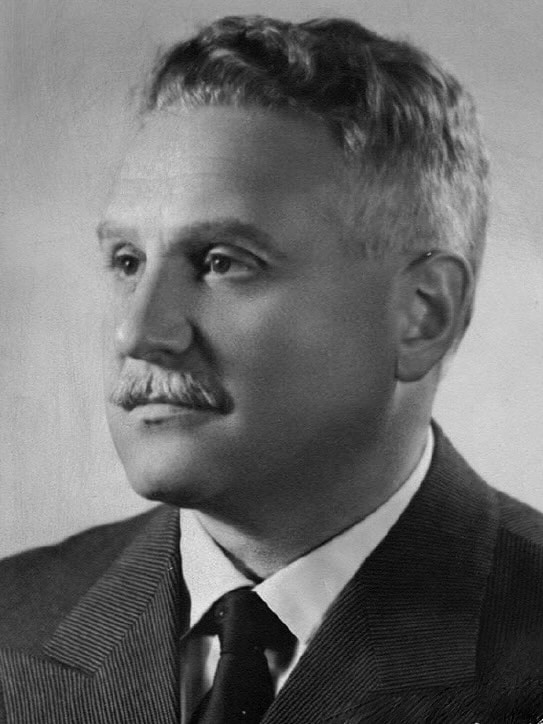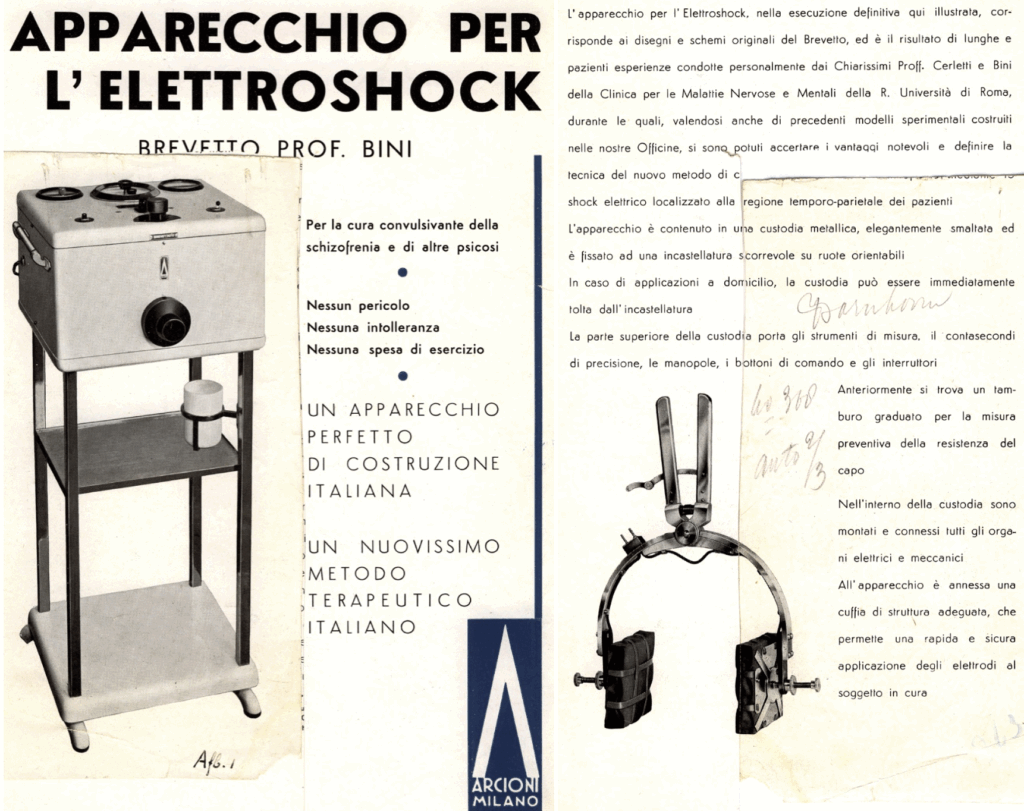Lucio Bini

Lucio Bini (1908–1964) was an Italian psychiatrist
Bini was a neurophysiologist and psychiatrist best known for co-developing electroconvulsive therapy (ECT) with Ugo Cerletti in 1938. He studied medicine at the Sapienza University of Rome and worked under Cerletti at the Neuropsychiatric Clinic. He was instrumental in designing and assembling the first electroshock prototype, securing patents in Italy and abroad. His technical ingenuity made ECT a practical and reproducible treatment, replacing riskier seizure-induction methods such as metrazol.
Throughout the 1930s and 1940s, Bini was a key figure in promoting ECT internationally. He personally presented the technique in Copenhagen in 1939 and held sole patents for the device in multiple countries. Despite his pivotal contributions, tensions arose between Bini and Cerletti in later years, leading to professional estrangement. Cerletti increasingly downplayed Bini’s role, even as Bini continued academic and clinical work, eventually becoming director of neurology at San Camillo Hospital in Rome.
Bini’s later years were overshadowed by the stigmatization of ECT and its marginalization in psychiatry amid the rise of psychopharmacology and anti-psychiatry movements. Nevertheless, he remained a respected figure, maintaining international collaborations, including ties with the Menninger Foundation in the U.S. Bini died suddenly in 1964 at age 56, just as disputes arose over the display of the original ECT apparatus.
Biographical Timeline
- Born September 18, 1908 in Rome, Italy.
- 1920s–1930s – Studied medicine at the University of Rome La Sapienza, trained in psychiatry and neurophysiology under Ugo Cerletti.
- Mid-1930s – Appointed assistant at the University of Rome’s Neuropsychiatric Clinic. Became Cerletti’s chief collaborator, with a particular focus on neurophysiological experimentation.
- 1937–1938 – Conducted animal studies using electric shocks to induce seizures in pigs and dogs, paving the way for clinical trials in humans.
- 1938 (April) – Co-performed the first human electroconvulsive therapy (ECT) alongside Cerletti, using a hand-built device designed by Bini.
- 1938–1939 – Secured patents for the ECT apparatus in Italy and abroad. Presented the method at the International Congress of Neurology in Copenhagen (1939).
- 1940s – Continued to refine ECT techniques and train other psychiatrists. His apparatus was widely adopted and replicated internationally.
- 1950s – Held senior academic and clinical positions, including Director of Neurology at San Camillo Hospital, Rome. Maintained international collaborations, notably with the Menninger Foundation in the U.S.
- 1950s–1960s – Published on ECT, psychiatric neurophysiology, and the ethical application of convulsive therapy. Maintained a cautious distance from Cerletti’s later acroagonine theory.
- 1964 – Died unexpectedly on August 15, 1964 in Rome, Italy aged 56
Medical Eponyms
Electroconvulsive Therapy (ECT)
On April 11, 1938, at the University of Rome, Ugo Cerletti and Lucio Bini conducted the first electroconvulsive therapy (ECT) on a human. After extensive animal studies and practical experimentation in abattoirs using electrical stunning equipment, they applied a controlled current to a patient with paranoid schizophrenia. The induced seizure resulted in significant improvement after repeated sessions.
Cerletti sought a simpler, non-toxic method to provoke epileptic convulsions… Electroshock, unlike cardiazol, induced immediate and absolute unconsciousness… without the distressing latency period… The attack was fundamentally identical to that obtained with cardiazol and should achieve the same beneficial effects—if not more
Cerletti and Bini, 1938
ECT rapidly gained international acceptance as a non-invasive, repeatable alternative to chemically induced seizures. It was significant in the pre-antipsychotic era, offering symptomatic relief in major depression, mania, and catatonia. Despite later controversy and ethical debate, it remains an effective treatment for severe, treatment-resistant depression today.
Cerletti–Bini Electroshock Apparatus (1938)
Lucio Bini was the technical and physiological architect behind electroconvulsive therapy (ECT), co-developed with Ugo Cerletti in 1938. He constructed the original Cerletti–Bini apparatus, a device that could safely induce seizures via electrical stimulation, using adjustable current settings and dual electrodes.
If Cerletti discovered the technique, Bini made it usable. One without the other would have meant little
Kalinowsky 1965
Originally intended as a research instrument to explore “therapeutic epilepsy,” the device was rapidly adapted for clinical use. A prototype is preserved at the Museo di Storia della Medicina in Rome. Bini was listed as the sole patent holder in Italy, the UK, the U.S., and several other countries. He personally introduced the method internationally, including at the 1939 Copenhagen Neurological Congress

1939 – At the Third International Neurological Congress in Copenhagen, Bini introduced electroconvulsive therapy (ECT) to a global audience for the first time. Bini delivered a detailed presentation titled “Seizures triggered through electrical current (electroshock)” in German, describing the technical, physiological, and clinical aspects of the newly developed therapy.
This method permits controlled, repeatable seizures without the adverse psychic effects caused by cardiazol… The psychotic symptoms receded gradually with successive treatments.
Bini 1939
His lecture outlined extensive preclinical animal trials, the physiological parameters of induced seizures, and the design of the ECT apparatus. Bini discussed the optimal settings for voltage (130–145 V), current frequency (approx. 45 Hz AC), electrode placement on the temples, and seizure classification (complete vs. incomplete). He emphasised the treatment’s safety, reporting no complications in over 3,000 cases to date.
Controversies
1950s-1960s Tensions between Cerletti and Bini grew. Cerletti increasingly portrayed himself as the sole originator of ECT, omitting Bini’s contributions from public narratives and interviews. In 1963, shortly before Bini’s death, the original apparatus was displayed in museums and exhibitions under Cerletti’s name alone. Colleagues and students later contested this portrayal, emphasising that the invention of ECT was a true scientific collaboration.
This controversy reflects the broader marginalisation Bini experienced in his later career. Despite his essential role, he did not receive equivalent recognition, and his name was often overshadowed in discussions of ECT’s legacy.
Major Publications
- Bini L. Experimental researches on epileptic attacks induced by the electric current. Proceedings of the 89th meeting of the Swiss Psychiatric Association at Munsingen, Berne. May 29-31, 1937.
- Bini L. Richerche sperimentali nell’accesso epilettico da corrente elettrica. Schweizer Archiv fur Neurologie und Psychiatrie 1937; 39(S): 121–122.
- Bini L. Experimental researches on epileptic attacks induced by the electric current. American Journal of Psychiatry 1938; 94(S): 172–174.
- Cerletti U, Bini L. L’Elettroshock. Archivio Generale di Neurologia, Psichiatria e Psicoanalisi 1938; 19: 266-268
- Bini L. Der Durch Elektrischen Strom Erzeugte Krampfanfall (Elektroschock). III Congres Neurologique International. Einar Munksgaard-Copenhague, 1939; 121: 706–708.
- Bini L. La tecnica e le manifestazioni dell’elettroshock. Rivista Sperimentale di Freniatria 1940; 18: 361–458.
- Bini L. Professor Bini’s notes on the first electro-shock experiment. Convuls Ther. 1995 Dec;11(4):260-1.
References
Biography
- Kalinowsky LB. Lucio Bini (1908-1964). Am J Psychiatry. 1965 Apr;121:1041-2.
Eponymous terms
- Faedda GL, Becker I, Baroni A, Tondo L, Aspland E, Koukopoulos A. The origins of electroconvulsive therapy: Prof. Bini’s first report on ECT. J Affect Disord. 2010 Jan;120(1-3):12-5.
- Aruta A. Shocking waves at the museum: the Bini-Cerletti electro-shock apparatus. Med Hist. 2011 Jul;55(3):407-12.
- Rzesnitzek L, Lang S. A Material History of Electroshock Therapy. N.T.M. 2016; 24, 251–277
- Sirgiovanni E, Aruta A. The electroshock triangle: disputes about the ECT apparatus prototype and its display in the 1960s. Hist Psychiatry. 2020 Sep;31(3):311-324.
Eponym
the person behind the name
BA MA (Oxon) MBChB (Edin) FACEM FFSEM. Emergency physician, Sir Charles Gairdner Hospital. Passion for rugby; medical history; medical education; and asynchronous learning #FOAMed evangelist. Co-founder and CTO of Life in the Fast lane | On Call: Principles and Protocol 4e| Eponyms | Books |
